Little Ringed PloverRinged PloverKittlitz's PloverKentish PloverGreater Sand PloverCaspian PloverDotterelEuropean Golden PloverGrey PloverSpur-winged PloverSociable PloverWhite-tailed PloverNorthern Lapwing
Little Ringed Plover🠉
Charadrius dubius
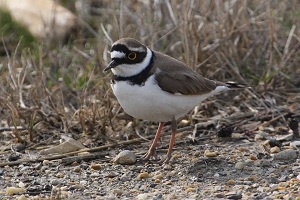
Small wader with the bill almost completely black (pale base to the lower mandible), thin and short. Looks slimmer and more elongated than the Ringed Plover. In flight, has no wingbar, and the dark patch on the ear-coverts is usually downward-pointing at the rear. Long tertials, covering most of the primaries. Adult: distinctive yellow eye-ring and pale brown or greyish-yellow legs. Collar, eye-stripe and upper forehead black, turning brown in winter. Supercilium and lower forehead then cream-coloured. Juvenile: like the adult in non-breeding plumage but upperparts more scaly, indistinct buff supercilium, narrow eye-ring and legs yellower.
Call: “piu”, slightly descending the scale.
L. 15.5-18 cm ; W. 32-35 cm.
Similar species: Ringed Plover, Kentish Plover, Kittlitz's Plover.
©Thomas Galewski
Ringed Plover🠉
Charadrius hiaticula
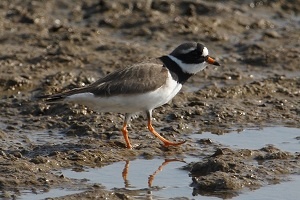
Similar to the Little Ringed Plover but stockier and deeper-chested. The primary projection is longer. Clear white wingbar. Broad distinct whitish supercilium behind the eye always present.
Adult in breeding plumage: legs and base of bill orange.
Adult in non-breeding plumage: the black areas become brownish, and some individuals have the bill almost all black.
Juvenile: the feathers of the upperparts are narrowly edged pale, and the legs are dull orange to yellowish.
Call: “du-i” or “pui” ascending the scale.
L. 17-19.5 cm ; W. 35-41 cm.
Similar species: Little Ringed Plover, Kentish Plover, Kittlitz's Plover.
©Thomas Galewski
Kittlitz's Plover🠉
Charadrius pecuarius
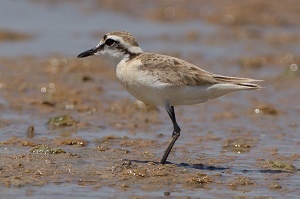
About the same size as Kentish Plover, but with longer legs. In flight, the legs extend beyond the tail, and the inner primaries have a broad white area at the base, with the fore part of the wing dark.
Adult breeding: distinctive head pattern with the crown grey-brown with a dark band at the front. Lores and ear-coverts black. Nape, forehead and throat white, the throat contrasting with the orange chest. Upperparts grey-brown with dark markings.
Adult non-breeding and juvenile: broad orange-buff supercilium and orange-buff nape. Chest orange-buff, forming a narrow band in the juvenile. Dark scapular patch.
Voice: a short “tchik” and a dry “drrr”.
L. 14-16 cm. ; W ?
Similar species: Kentish Plover, Greater Sand Plover.
©Frédéric Pelsy
Kentish Plover🠉
Charadrius alexandrinus
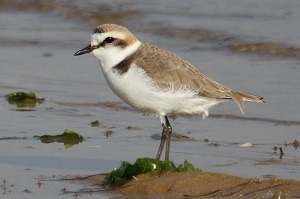
A little smaller than the Ringed Plover with longer legs, a finer bill, and a broader, less rounded head. Paler-coloured. Distinguished from other small plovers in all plumages by the two small dark patches on the sides of the chest, the entirely black bill and the blackish legs. It shows a white wingbar, and white sides to the tail. In breeding plumage, the female is duller than the male. The non-breeding adult and juvenile are like the breeding female, the juvenile having fine scaling on the upperparts.
Call: “twee-trtrtr” at rest, also soft “twit” or “trruu”.
L. 15-17 cm ; W. 42-45 cm.
Similar species: Little Ringed Plover, Ringed Plover, Kittlitz's Plover.
©Thomas Galewski
Greater Sand Plover🠉
Charadrius leschenaultii
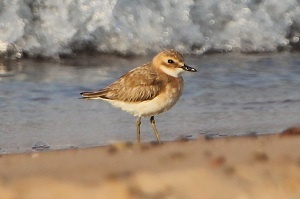
More like a Grey Plover in shape than a Kentish Plover but smaller, more slender, and with longer legs. Long, heavy bill, often seeming disproportionately large, with an extended tip. Body elongated. Legs mainly greenish or yellowish-grey.
Male breeding: grey above, tinged with orangeish. Crown grey, orangeish at the front. Nape orangeish. Forehead and throat white. Ear region and lores black. Chest and foreflanks rusty, rest of underparts white.
Female and adult non-breeding: duller, and greyer on the upperparts.
Juvenile: like the non-breeding adult, but very rusty-scaled above.
Voice: flight call a trilled “trrr”, often doubled or repeated.
L. 19-22 cm ; W. 53-60 cm.
Similar species: Kentish Plover, Kittlitz's Plover, Caspian Plover.
©Thomas Galewski
Caspian Plover🠉
Charadrius asiaticus
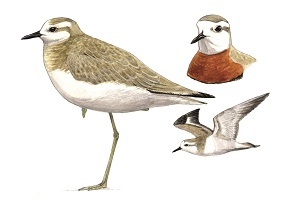
Recalls Greater Sand Plover but looks slimmer and more elongated. Very clear pale supercilium behind the eye, distinctive in all plumages. No white on the sides of the tail. Faint wingbar in flight.
Male breeding: forehead, lores, throat, and cheeks pure white. Ear-coverts and crown brown. Broad rusty-brown pectoral band with a narrow black border below.
Female breeding: like the male except that the chest is smudgy brownish and the throat dirtier.
Adult non-breeding: distinguished from Greater Sand Plover by the very white forehead, broad white supercilium, and lack of clear pectoral markings on the sides of the chest.
Juvenile: like the adult, but with very clear pale edgings above.
Voice: “tchup”, often given twice.
L. 19-21 cm ; W. 55-61 cm.
Espèce similaire : Greater Sand Plover.
Dotterel🠉
Charadrius morinellus
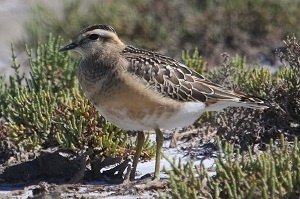
A little smaller and stockier than Grey Plover, Dotterel is distinguished from the other plovers in all plumages by a broad white or brown-yellow supercilium, absence of wingbars making the wings look more uniform, the white shaft of the outer primary, and dull-yellow legs. The adult in breeding plumage is distinctive: broad white supercilium contrasting with the dark crown (especially at the rear), narrow black and white pectoral bands, rufous-brown chest and dark belly. Adult in non-breeding plumage: Feathers of the upperparts and upper wing coverts grey with buffish edges. Broad buff supercilium. Chest and flanks greyish with buffish tinge. Narrow pale pectoral band. The juvenile is like the non-breeding adult, but the feathers of the upperparts are blackish brown.
Call: soft rolling “piiurr”.
L. 20.5-24 cm ; W. 57-64 cm.
Similar species: Grey Plover, European Golden Plover.
©Thomas Galewski
European Golden Plover🠉
Pluvialis apricaria
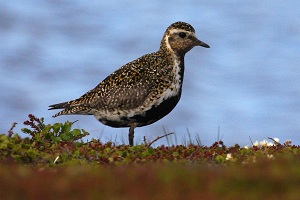
Slimmer and a little smaller than the Grey Plover, it has slightly narrower wings, and its wingbeats are faster. In flight, the axillaries are always white, the rump is brown and the white wingbar is narrow. At rest, appears brown above at a distance. Adult breeding: dark grey above with the feathers broadly edged with yellow-brown and white. More or less black below. The adult in non-breeding plumage and juveniles have similar plumage, but the upperparts are speckled with yellow-brown only and the underparts are pale.
Call: a whistled “tlu” or “tlui”.
L. 25-28 cm ; W. 53-59 cm.
Similar species: Grey Plover, Dotterel.
©Thomas Galewski
Grey Plover🠉
Pluvialis squatarola
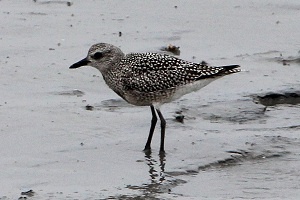
Long-legged wader with a short bill and neck, quite bulky, the size of a big thrush. The black axillaries are distinctive in all plumages. It also has a broad white wingbar, and a white crown. The adult in breeding plumage is black below. The adult in non-breeding plumage is grey above with the feathers edged white, and whitish below. The juvenile is like the adult non-breeding, but is blacker above, the feathers edged with yellow-buff, and the chest is densely streaked with brown on a yellow-tinged background. Belly white.
Distinctive call: a melancholy “tlee-oo-ee”.
L. 26-29 cm ; W. 56-63 cm.
Similar species: European Golden Plover, Dotterel.
©Thomas Galewski
Spur-winged Plover🠉
Vanellus spinosus
Slightly smaller than the Northern Lapwing, and a little slimmer, with longer legs. Plumage distinctive, with a large white area on the cheeks. Crown, throat, centre of neck, and belly black. Back and smaller wing coverts brown-grey contrasting with the black remainder of the wing (black and white seen from below). Tail with a broad black terminal band. The juvenile is like the adult, but with the upperparts heavily spotted and edged.
Voice: disyllabic , grating “pi-ik”.
L. 25-28 cm ; W. 70-80 cm.
Similar species: Sociable Plover, White-tailed Plover.
©Thomas Blanchon
Sociable Plover🠉
Vanellus gregarius
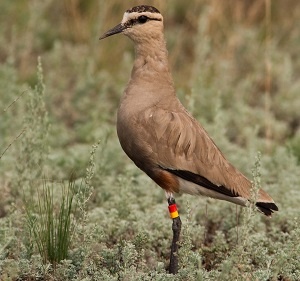
Size and shape recalling the Northern Lapwing, but slightly smaller and legs a little longer. In all plumages, broad whitish supercilium, blackish legs, and tricoloured upperwing: grey-brown, black and white. The adult in breeding plumage has the crown and belly dark with the chest greyish. The non-breeding adult has the chest paler and the belly white. The juvenile has the chest diffusely streaked and the belly white.
Voice: harsh “kretch” and a repeated “krett-ti-ett-eti”.
L. 27-30 cm ; W. 65-70 cm.
Similar species: Spur-winged Plover, White-tailed Plover.
White-tailed Plover🠉
Vanellus leucurus
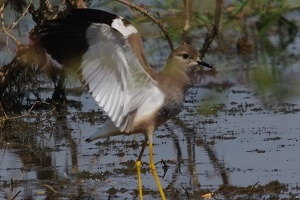
About the same size as the Northern Lapwing, it has a long bill and very long yellow legs, which give it an elegant appearance. The large dark eye stands out clearly against the uniform head. The tail is all white.
Voice: repeated high-pitched, squeaking “pit-ee-weee”, and a plaintive “pee- week”.
L. 26-29 cm ; W. 67-70 cm.
Similar species: Spur-winged Plover, Sociable Plover.
©Pierre Defos du Rau
Northern Lapwing🠉
Vanellus vanellus
Medium-sized wader, of similar size to a pigeon, with a black, green-glossed back and white belly. The Northern Lapwing has a crest 5 to 7 cm long (shorter in juveniles). It has broad rounded wings producing a distinctive black-and-white pattern. Its flight is strong and flappy due to the slow wingbeats.
Call: characteristic “pee-wit”.
L. 28-31 cm ; W. 67-72 cm.
Similar species: Spur-winged Plover, Sociable Plover, White-tailed Plover.
©Thomas Galewski






